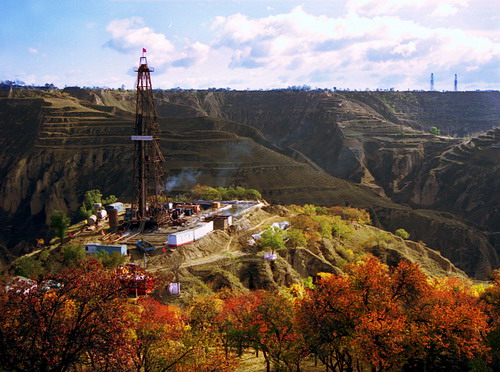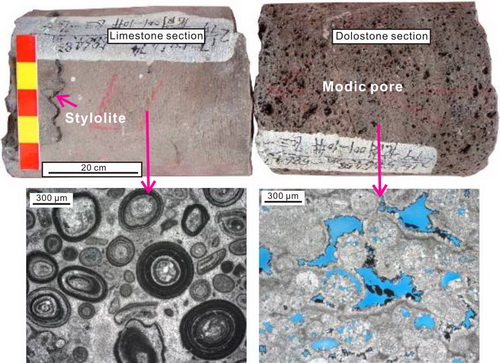Researchers Uncover the Role of Diagenesis Impacts on Carbonate ReservoirsUpdate time:01 29, 2018
Exploration and development of carbonate oil and gas reservoirs in Tarim Oilfield.(Image from CNPC) Due to the great potential for future petroleum resource discoveries, deeply buried (> 3,500 m) carbonate reservoirs are currently hot exploration targets in many of China's sedimentary basins. The roles played by diagenesis impacts in regard to carbonate reservoir development are still poorly understood, and are also sometimes controversial. Therefore, this has been currently hampering the world-wide petroleum exploration and production planning processes. Associate Professor JIANG Lei and his colleagues at IGG have determined that, when compared to limestone, deeply buried dolostone appears to have much better petroleum reservoir potential. This has been determined to be mainly due to the following factors: (1) Dolostone performs much better in the preservation of parimy porosity; and (2) Thermochemical sulfate reduction (TSR) tends to further enhance the reservoir quality in dolostone. In their research study, each diagenetic event's impact on the quality of the reservoirs was further quantitatively evaluated, either from the point of view of counting the data, and/or the diagenetic modelling results. The results were then published in the Geochimica et Cosmochimica Acta(Link) and Marine and Petroleum Geology(Link). In this study, oolitic limestone and dolostone core samples from the Early Trassic Age were collected from the shoal facies of the eastern Sichuan Basin. A combination of petrology, fluid-inclusion microthermometry, stable and radiogenic-isotopes, and point counting, along with the modelling of the diagenesis, pressure, porosity, and permeability, was used to constrain the diagenetic impacts on the reservoir development. When compared with limestone, with an average porosity of < 2% due to early calcite emplacement, dolomstone is known to have much better reservoir quality (with an average porosity value of approximately 10%). Therefore, dolomitization has preserved more porosity from calcite precipitation by compaction. The diagenetic modelling results showed that the TSR had enhanced the porosity by approximately 1.6%, which led to a reservoir permeability increase from 110 mD to 264 mD, as supported by the permeability modelling. The fluid pressure modelling results showed that overpressure had occurred and was perhaps related to the TSR, which may have led to the maintenance of the porosity due to the inhibition of the compactional processes. Finally, this study summarized the mechanisms for the TSR of the origin of the secondary porosity in the carbonates as follows: (1) There were density differences between the reactant anhydrite and the product calcite; (2) New water was added; and (3) Acidity was the generated during the reaction of the new H2S with a siderite component in the pre-existing dolomite of the reservoir. The results of this study were the first to quantitatively answer why deeply buried dolostone had better reservoir quality when compared to the limestone countparts, and also clarified the role of the TSR impacts on the quality of carbonate reservoirs. This study was conducted in collaboration with the University of Liverpool; the University of Texas at Austin; and the PetroChina Hangzhou Research Institute of Geology. This research study was supported by the National Natural Science Foundation of China; the Youth Innovation Promotion Association of the Chinese Academy of Sciences; the National Science and Technology Major Project; the Office of the China Postdoctoral Council; and the Chinese Scholarship Council.
Figure 1. Core and photomicrographic images show that there is abundant vuggy porosity (in blue) present in the oolitic dolostone, whereas the porosity in the oolitic limestone was very low due to heavy calcite cementation. Lower Triassic Feixianguan Formation, Sichuan Basin, China.(Image by JIANG)
|
Contact
Reference
|
-
SIMSSecondary Ion Mass Spectrometer Laboratory
-
MC-ICPMSMultiple-collector ICPMS Laboratory
-
EM & TEMElectron Microprobe and Transmission Electron Microscope Laboratory
-
SISolid Isotope Laboratory
-
StIStable Isotope Laboratory
-
RMPARock-Mineral Preparation and Analysis
-
AAH40Ar/39Ar & (U-Th)/He Laboratory
-
EMLElectron Microscopy Laboratory
-
USCLUranium Series Chronology Laboratory
-
SASeismic Array Laboratory
-
SEELaboratory of Space Environment Exploration Laboratory
-
PGPaleomagnetism and Geochronology Laboratory
-
BioMNSFrance-China Bio-mineralization and Nano-structure Laboratory

 Print
Print Close
Close


